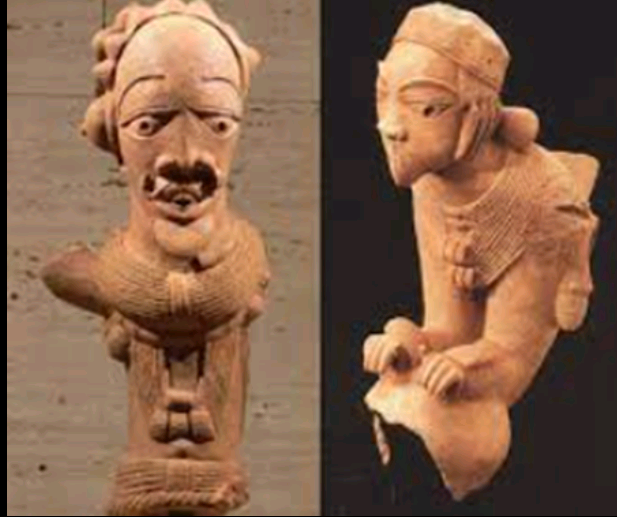The perception of Nigeria as well as the rest of Africa as a ‘dark continent’ without history, wisdom, or advanced civilization by the Western world, has long been shattered. Shockingly intricate and refined relics of ancient African history, in the form of artworks, have given a glimpse into past civilizations and their activities. One of them is the huge collection of unearthed terracotta and bronze sculptures which revealed the existence of the Nok culture.
Most African tribes do not have a documented or written form of history, especially in their own native languages. Furthermore, lack of documentation may have made it difficult to access the history of past African cultures beyond a few thousands of years. Nevertheless, their unique storytelling, cultural relics, and various forms of art, have given some degree of authenticity to their ancient wisdom and origins. Africans are proud to say they are far from being barbaric.
About the Nok Culture
It is believed that both the Nok and Gajiganna people of northern Nigeria may have migrated from the Central Sahara. They brought pottery and pearl millet along with them. And they went in different directions to settle independently of each other upon arrival. The Nok people may have also migrated from West African Sahel. It is estimated that the Nok culture likely existed between 1500 BCE and 1 BCE.
The figurines also suggest that they may have been created on a large scale as part of complex funeral rites. To support this belief, some meaningful quantities of charcoal, ceramics, stone-beaded necklaces, and other organic items, were found in burial pits amongst the sculptures. Additionally, there was a notable difference in the soil coloring of these burial pits and that of the surroundings. But several other past activities were depicted by these figurines. They include hunting (with slingshots, bows and arrows); as well as fishing and transporting goods (with dug-out canoes).
It is believed that the Nok people may have been the ancestors of the Yoruba, Jukun, and Dakakari people. This hypothesis was drawn from the observed similarities in culture and art forms between the Nok people of northern Nigeria, and the other mentioned tribes. It is also believed that the terracotta sculpture tradition of the ancient Nok culture could have influenced the artistic traditions of later West African cultures. Such cultures include the Igbo-Ukwu, Ile-Ife, and Bini (Nigeria); Koma (Ghana); Bura (Niger), and Jenne-Jeno (Mali). Yet again, studies revealed that the Nok culture may have developed their iron metallurgy industry sometime between 750 BCE and 550 BCE.
Various Discoveries of the Nok Sculptures
To have unearthed life-sized terracotta sculptures with such intricate details at the site of a tin mine, must have been a shock. In 1928, the first-ever Nok terracotta sculpture was found by accident. The location was a tin mine within the environs of the village of Nok (Kaduna state), not too far from the Jos plateau. It was dug out from depths of about 24 feet. Yet again in 1932, another set of 11 statues were found in good condition somewhere close to the city of Sokoto. And then more statues were unearthed in Katsina. These two sets of terracotta figurines appeared similar to the classical Nok style; but no clear connection between them has been established.
The discoveries continued in 1943, when several new terracotta figurines were found near the village of Nok in a tin mine. It was unearthed by a worker, who decided to take it home. The figurine served the purpose of a scarecrow on his farm for about a year. Then the director of the mine saw it, and subsequently bought it. By 1977, up to 153 pieces of terracotta sculptures had been found at the tin mining sites. The mining sites covered areas within Northern and Central Nigeria – noted to be dried-up riverbeds in the savannah. It was deduced that flood waters from nearby valleys, coupled with erosion, could have resulted in the deposition of these sculptures at various depths.
Most of these sculptures were found in fragments, scattered all over the place. However, several male and female sculpted heads (complete with unique hairstyles, jewelry, and other objects) were preserved in clear enough detail. Further findings were made in areas as far south as the Middle Niger Valley and the Lower Benue Valley. Thankfully, the Nok sculptures found at two sites (Taruga and Samun Dukiya) were of great assistance to archaeologists, as they had remained unmoved. They were able to estimate the ages of these sculptures (through radiocarbon and thermo-luminescence tests) to be something between 2,000 and 2,500 years old.
Thus, the Nok sculptures are taken to be the oldest form of life-sized terracotta sculptures to be produced in West Africa. And because of the similarities in their artworks, it is believed that the Nok culture may have been the precursor of the later Yoruba culture of Ile-Ife. A physiologist and engineer, A. O. Olubunmi even posits that proto-Yorubas could have created the Nok culture. And that the sudden disappearance of the Nok civilization was likely due to the disappearance/exit of Yorubas from northern Nigeria. This occurred during the time of large-scale massacre, expulsion and racial assimilation that followed the arrival of Islam in that region.
On the other hand, archaeologist Bernard Fagg connected the Nok culture to the Ham (or Jaba) and other ethnic groups within the region of central Nigeria. He drew the conclusion from his observation of similar dressing and cultural practices between these existing ethnic groups, and those observed on the Nok figurines.








